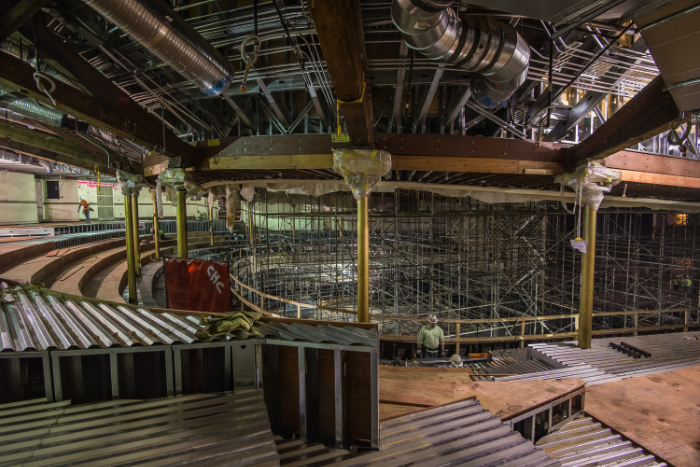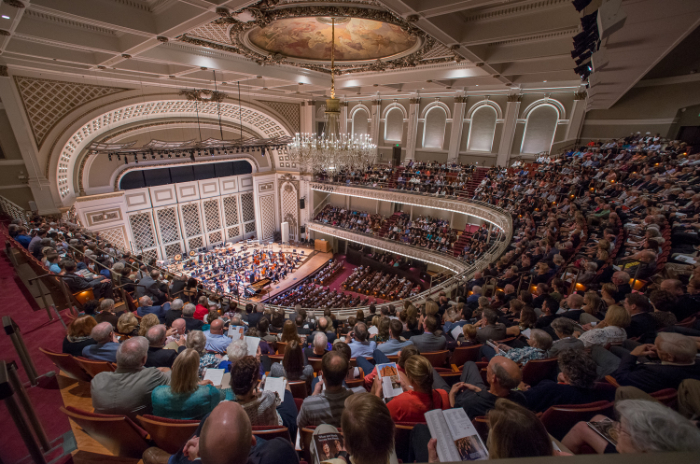
Photo credit: Jackie Stevens
The Cincinnati Symphony Orchestra is back in Music Hall! After a lengthy renovation, the hall reopened with a five-week celebration of opening galas featuring each of the five performing arts organizations in residence. The CSO managed to navigate some very stressful and difficult territory with a lot of success, thanks to a thoughtful approach and willingness to discuss openly the potential and real problems we encountered. Although the actual construction took only nineteen months, as every veteran of a major hall renovation or construction project can tell you, the process is much longer than the construction.
In 2011, an ambitious plan for the renovation of Cincinnati Music Hall was laid out, including major modifications to the interior of the auditorium (including a reduction in the seating capacity), vastly improved and expanded patron amenities connecting the hall to neighboring Washington Park, and a great deal of much-needed repair of outdated and failing infrastructure. Unfortunately, although progress was made on the first steps of the process, the project ultimately needed to be set aside for a time as the result of financing difficulties.
In 2014, a new financing plan was devised, involving ambitious historical tax credits, a diminished scope for the project, a county tax bond, and most importantly, a 72-year lease agreement from the city to the Music Hall Revitalization Company, the non-profit created in 2010 to spearhead the renovation. The project survived a temporary setback when the tax bond intended to link the renovation of Music Hall with the renovation of Union Terminal, another Cincinnati landmark, was modified to exclude Music Hall—the Cincinnati philanthropic community stepped up and filled the resulting shortfall in the $143 million project.

The interior of the hall under construction. More images of the project can be found here
Photo credit: Matthew Zory
A unique feature of Music Hall as the home of a major American orchestra is that it is not a symphonic hall, but a multi-purpose hall that is also home to the Cincinnati Pops, the Cincinnati Opera, the Cincinnati Ballet, and the Cincinnati May Festival (an annual festival of choral music with orchestra). Each of these groups requires a different stage or pit configuration and demands different support from the infrastructure of the auditorium. This made planning the renovation a complex balancing act involving tradeoffs between the needs of each performing group in the context of a limited budget.
The renovations backstage were necessarily fairly minimal. A large percentage of the budget was taken up by infrastructural needs, and the patron experience in the auditiorium and in the public spaces was given priority throughout. As a result there remain problems backstage, and we are currently in the process of determining which resident company bears responsibility for which issues. Our management is still communicative and working with us to resolve the outstanding issues, but in a project as vast as this one, there are many to address; although our issues loom large to us, the importance of things such as working telephone systems for the box office are also important to the organization as a whole.
When the project was getting established again, one of the aspects which helped to make it successful was an extraordinarily high degree of cooperation and communication on the part of CSO stakeholders, and amongst the resident companies at Music Hall.
Looking back on the renovation attempt from 2011, the musician representatives of the CSO realized that how the acousticians had operated made us highly uncomfortable—their engagement was shrouded in a great deal of secrecy, and they had a reliance on computer modelling and a seeming lack of regard for the input of the musicians and artistic staff. In a series of meetings, first with our management and subsequently with 3CDC, the project managers, we figuratively lay down on the tracks and demanded that the project be reopened to bids from other acoustical firms. We wanted to guarantee that no matter the result, there would be a higher degree of buy-in and engagement from the start of this new project. Although this put an already tight schedule under even more stress, the entire project was re-opened for bids, and after an extensive search process, 3CDC engaged a new acoustical firm, Akustiks.

View from the gallery during the opening concert
Photo credit: Matthew Zory
The new acousticians worked with musician representatives, and in open meetings with the entire orchestra invited us to determine our priorities inside the auditorium. We identified the existing positive acoustic qualities of Music Hall, and what aspects we wanted to see improved. We engaged in a series of acoustical mock-ups prior to the closing of the hall, to determine as best as possible if the proposed changes to the interior of the hall would be beneficial. Over two days of rehearsals, a stage extension was built so the orchestra could be moved further into the hall, the existing acoustic shell towers were reconfigured, the existing acoustical canopy was raised, lowered, and removed; the orchestra filled out detailed surveys regarding each configuration.
During our nineteen months out of Music Hall, our acousticians also worked to improve our experience in our temporary home at the Taft Theater. They designed a re-purposed acoustic shell from our outdoor summer home, and designed an easy-to-construct adjustable ceiling for our stage managers to build and install. Although our experience in the Taft was difficult in almost every way, I am confident that we had a better experience because of the acoustical work done.
Upon our return to Music Hall, we again tested various configurations of the adjustable aspects of the hall. The new acoustical clouds were raised and lowered and their angles were adjusted. Soft goods were added to and then ultimately removed from the shell towers at the rear of the stage and around the auditorium walls surrounding the thrust stage. The orchestra was again surveyed regarding the results of each change, and we played a series of acoustical test concerts with an audience in the hall.
Throughout the process, musicians representatives were consulted and engaged at every step of the way. The final result, although still in process, is a vast improvement over the previously muddy and indistinct acoustics of Music Hall. The patron amenities are greatly improved, and we are thrilled to be performing in a hall which reflects and showcases the quality of the world class orchestra we have here in Cincinnati, and we are looking forward to an inspiring future.





